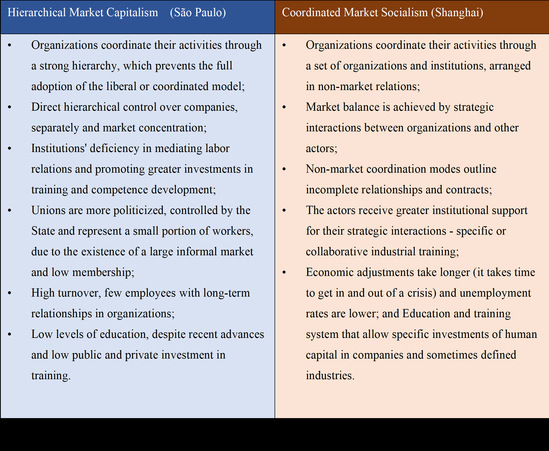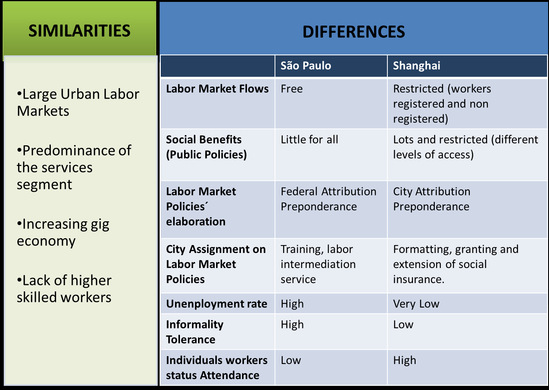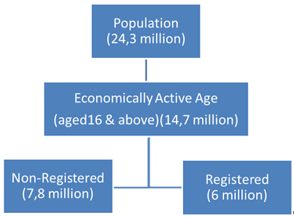作者: Prof. Dr. Wilson Amorim, Ney N. Miyahira, Prof. Dr. Ping Zhang and Rongju Kong 发布时间:2020-04-16 来源:富达平台+收藏本文
Smart City is defined as a system of people interacting and using energies, materials, services and financing to catalyze economic development and improve the quality of life. Faced with such multidisciplinarity brought by the concept, there is concern about the efficiency of public management, such as: how public policies can influence the dynamics of the labor market, impacting on the creation and maintenance of a smart city.
This article intends to realize comparative case studies of global cities (São Paulo and Shanghai). As a starting point, it is possible to present a summary comparison between labor market policies from two different realities: Shanghai and São Paulo. First, it is important to differentiate the two realities: by the lens of varieties of market economies it is possible to classify São Paulo as a hierarchical market capitalism and Shanghai as a coordinated market socialism.

Source: (Hall and Soskice[1], 2003; Schneider[2], 2007).
With the understanding of the differences in mind, it is possible to analyze the figures presented for each city, in relation to their labor markets. Guimarães[3] (2009) points out that the labor market must be understood in all its heterogeneous and multifaceted aspect. Such a view becomes even more relevant when one observes the changes arising from the restructuring of productive activities, the flexibilization of relations and the conditions of use of work, reflecting the socio-technological transformations, which expand work activity beyond the limits of formal work.Both cities have been going through these transformations. And in each case, the state intervention in the labor market needs to consider these new conditions of work and thus correct market failures, combat unemployment, improve the insertion of labor in the market and stimulate increased productivity and income.
São Paulo, being a Brazilian city, presents the main characteristics of the Brazilian labor market: regional and sectorial heterogeneity, large presence of informal employment, low wages and low professional qualification. Between 2003 and 2014 there was a period of economic growth, with Labor market warming and low unemployment, that ends after 2014, with severe recession, unemployment rate arising and stagnant wages. The scenario made the Congress (Legislative Branch of Brazil), supported by the government (Executive Branch), to take some actions to make Labor Law more flexible (Labor Reform in Nov2017 and Nov2019), changing labor conditions, job contracts, collective bargaining, Labor Courts and unions Organization. The main intention is to warm up the economy, creating new jobs, by promoting new flexible working arrangements and job contracts, propitiating non-standard employment relationship, individual bargaining an labor market fragmentation.
On the other hand, Shanghai, as a Chinese city, has the Communist history as influence, as in 1912 the Republic was proclaimed in China and the Chinese Communist Party emerged in Shanghai, giving rise to the Communist Revolution of 1949, which established the principle of legality, adopting a normative, in the Soviet way. Later, in 1960, with the Cultural Revolution, China abandoned this system, when conciliation committees were created, the so-called popular mediation commissions, which sought consensus solutions, since there were no positive rights, except for foreigners. Since then, with China Constitution (1982), New labor Law (1995) and Labor Reform (2008), the Labor Legislation in China was gradually moving towards the worker protection in the Labor Market. towards worker protection in the labor market It is an opposite movement from Brazil. These movements seem to be the responses of the respective governments, given the new context of labor transformations, but also considering the historical-political formations of the two locations.

Source: Prepared by authors
The similarities existing for the two cities are due to this new context, their differences are shown in the table and, even with great differences, they share the same desire: to become smart cities, providing labor market policies that reduce unemployment, heat the economy and promote social well-being.
About the authors:
Wilson Amorim is associate professor of the School of Economics, Management and Accounting of the University of São Paulo, Brazil. He has been a visiting scholar at Fudan Development Institute, Fudan University in 2019.
Ney N. Miyahira is PhD candidate of the School of Economics, Management and Accounting of the University of São Paulo, Brazil. He has been a visiting scholar at Fudan Development Institute, Fudan University in 2019.
Prof. Dr. Ping Zhang is associate professor of the School of International Relations & Public Affairs of Fudan University.
Rongju Kong is Section Chief of Labor Relations and Security Section, Yangpu District Human Resources and Social Security Administration of Shanghai.
APPENDIX
São Paulo Main Figures – Labor Market 2019 – 3rd Quarterly

Shanghai Main Figures – Labor Market 2019

Source: IBGE, Continuous National Household Sample Survey - Continuous PNAD
The Status of Population Development in Shanghai (2019).
[1]Hall, P.; & Soskice, D. 2003. Varieties of capitalism – The institutional foundations of comparative advantage. Oxford Press, Oxford.
[2] Schneider, B.R., 2007. Hierarchical market economies and varieties of capitalism in Latin America. Journal of Latin American Studies, 41, 2009. pp 553-571.
[3] Guimaraes, N. A., 2009. À procura de Trabalho – Instituições de Mercado e Redes. Argvmentvm, Belo Horizonte.